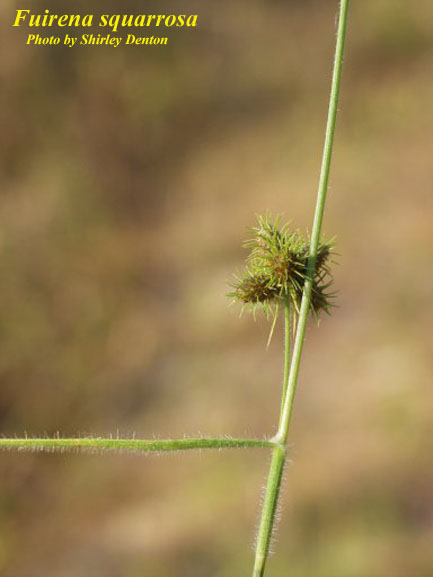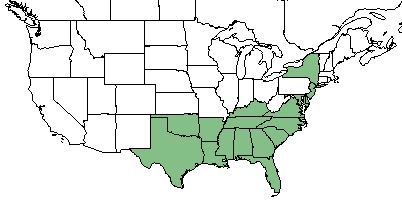Difference between revisions of "Fuirena squarrosa"
(→Description) |
|||
| Line 24: | Line 24: | ||
==Description== | ==Description== | ||
<!-- Basic life history facts such as annual/perrenial, monoecious/dioecious, root morphology, seed type, etc. --> | <!-- Basic life history facts such as annual/perrenial, monoecious/dioecious, root morphology, seed type, etc. --> | ||
| − | ''F. squarrosa'' is a native perennial graminoid that is a member of the Cyperaceae family <ref name= "USDA"> USDA Plants Database URL: https://plants.usda.gov/core/profile?symbol=FUSQ </ref>. | + | ''F. squarrosa'' is a native perennial graminoid that is a member of the Cyperaceae family <ref name= "USDA"> USDA Plants Database URL: https://plants.usda.gov/core/profile?symbol=FUSQ </ref>. Species in this family grow reproductive units in the form of spikelets, which contain highly simplified flowers <ref name= "Reutemann"> Reutemann, A. G., Vegetti, A. C., and Pozner, R. Inflorescence development in Abildgaardieae (Cyperaceae, Cyperoideae). Flora 210: 3-12. </ref>. |
==Distribution== | ==Distribution== | ||
Revision as of 15:18, 22 May 2018
| Fuirena squarrosa | |
|---|---|

| |
| Photo by the Atlas of Florida Plants Database | |
| Scientific classification | |
| Kingdom: | Plantae |
| Division: | Magnoliophyta - Flowering plants |
| Class: | Liliopsida - Moncots |
| Order: | Poales |
| Family: | Cyperaceae |
| Genus: | Fuirena |
| Species: | F. squarrosa |
| Binomial name | |
| Fuirena squarrosa Michx. | |

| |
| Natural range of Fuirena squarrosa from USDA NRCS Plants Database. | |
Contents
Taxonomic Notes
Synonyms: Fuirena hispida Elliott
Varieties: none
Description
F. squarrosa is a native perennial graminoid that is a member of the Cyperaceae family [1]. Species in this family grow reproductive units in the form of spikelets, which contain highly simplified flowers [2].
Distribution
The species can be found in the Southeast United States, ranging from Texas to Virginia, as well as in the Northeast in Maryland, New Jersey, and New York [1].
Ecology
Habitat
F. squarrosa can be found in mesic communities, including sphagnous bogs [3]. As well, it can be found infrequently in pine-palmetto communities and wet prairies [4].
Associated species - Eleocharis tuberculosa, Gentiana saponaria, Bartonia paniculata, Platanthera cristata, Pyrus arbutifolia, and Viburnum nudum [3].
Fire ecology
Sphagnous bogs and other similar communities are fire dependent due to their high acidity, which makes F. squarrosa dependent on fire frequency [5].
Conservation and Management
Cultivation and restoration
Photo Gallery
References and notes
- ↑ 1.0 1.1 USDA Plants Database URL: https://plants.usda.gov/core/profile?symbol=FUSQ
- ↑ Reutemann, A. G., Vegetti, A. C., and Pozner, R. Inflorescence development in Abildgaardieae (Cyperaceae, Cyperoideae). Flora 210: 3-12.
- ↑ 3.0 3.1 Bridges, E. L. and S. L. Orzell (1989). "Syngonanthus flavidulus (Eriocaulaceae) new to Mississippi." SIDA, Contributions to Botany 13(4): 512-515.
- ↑ Hilmon, J. B. (1964). "Plants of the Caloosa Experimental Range " U.S. Forest Service Research Paper SE-12
- ↑ Campbell, C. S. (1983). "Systematics of the Andropogon virginicus complex (Gramineae)." Journal of the Arnold Arboretum 64(2): 171-254.